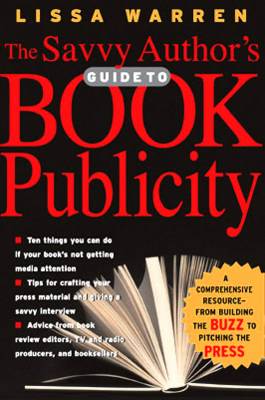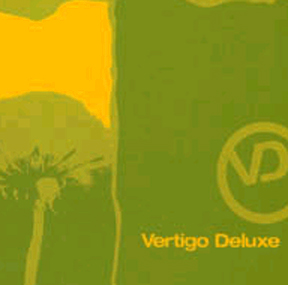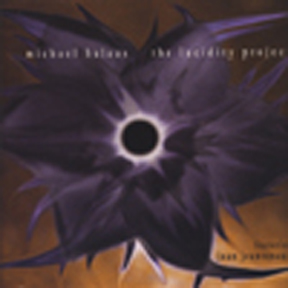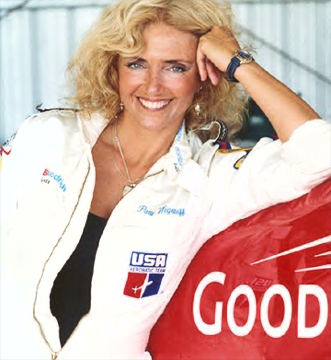 LIVES: Patty Wagstaff, stunt pilot
LIVES: Patty Wagstaff, stunt pilot
"Fly Girl"
I think that sometimes things choose you, rather than you choosing them.
I didn't know anything about stunt flying or aerobatics while I was growing up in Japan. My father was an airline captain. My sister is also an airline captain. They both influenced me to fly, but growing up, my parents told me that girls didn't become pilots, that I would just become a wife and mother.
My dad had books on flying -- airplane manuals that I used to love to read. I always offered to quiz him when he had a checkride coming up. I read his aviation novels. I had airplane posters on my wall.
Airplanes always represented freedom and escape, adventure. But in Japan there weren't any airshows and very little "general aviation" (small craft aviation).
Years later, I was living in Alaska and taking flying lessons from my ex-husband and other instructors.
I'd never seen aerobatics, just heard about them. Living in Alaska, there wasn't much chance for exposure to them, so we traveled to the states (in Alaska they call it the ‘Lower 48’) and went to an airshow, then to an aerobatic competition.
 Photo: Charles Stites
Photo: Charles Stites
I remember watching the airshow in complete amazement. I watched the best pilots at the aerobatic competition and thought, "
I can do that! I can do that, I can be one of them -- and that's where I belong."
I went back to Alaska, took aerobatic lessons and one thing led to another. I flew my first airshow in May of 1984 and flew in a contest in August of 1984, after flying my little airplane from Alaska to Wisconsin.
I think that by becoming a stunt pilot I was fulfilling and living my destiny. There were a series of things that brought me to the place where I could actually fly, learn aerobatics and continue with aerobatics. I always felt that whatever I was doing at the time would lead me to the right place eventually.
I particularly like the precision of aerobatics. I like flying a perfect loop, a perfect hammerhead -- a perfect maneuver.
I do all the maneuvers -- torque rolls (rolling and sliding backwards at the same time), lomcevaks (tumbling end over end), etc., but my biggest interest is doing some of the more simple-looking maneuvers with perfection.
I think I've always chosen activities (like jumping horses, competition aerobatics, etc.) that give you the most freedom, within the most disciplined structure. Only through great discipline can you achieve that freedom. Ironic, isn't it?
BASIC TRAINING
Staying in good physical condition is very important and makes you better at anything you do. Aerobatics specifically demands a lot of training to keep your G-tolerance up. During an airshow routine I pull up to l0 positive Gs and 8 negative Gs.
The Gs are very hard on your body and you have to condition yourself to them. I take a couple of months off in the winter, but when I start up again in early March it takes me several months to get in top condition again.
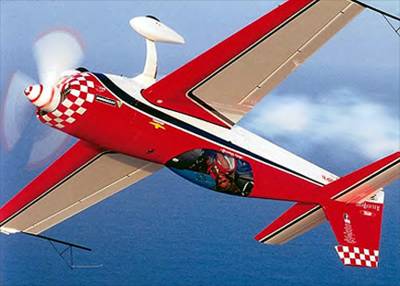 Photo: Jeff Berlin
Photo: Jeff Berlin
When you're in top condition, you can't take off more than a week or two before losing a lot of G-tolerance. You have to fly almost daily during the airshow season when you are doing really hardcore aerobatics. I also work out, go to the gym, swim and ride horses.
You can never forget that you have to be very focused before flying an airshow or performing a stunt. You have to take it very seriously and never be complacent, and that requires mental focus and concentration.
There have been studies done on aerobatic pilots. They are detail-oriented, extroverted introverts in general. They have good hand-eye coordination, the ability to focus and the need for excitement and challenge in their lives. And, yes, the ability to act under pressure and, in fact, excel under pressure.
The most difficult part of competition in any sport is presence of mind and mental control. Keeping your head together under pressure is what separates the winners from the losers.
CHAIN OF COMMAND
Flying in formation is not difficult, but it does take specialized skill. However, flying in close proximity to another airplane adds an element of danger that makes it extremely important to brief and prepare well on the ground and follow those rules while in the air.
If you can’t trust your "wingman," then you shouldn't be flying close to them in the air. Flying in formation takes a great deal of trust, skill and preparation.

Flying an airshow performance, aerobatic competition, or a stunt requires a great deal of team effort. I rely on my crew chief and mechanic to make sure the airplane is in top condition (and of course I check it over, myself).
I have to make sure that the fuel is not contaminated beforehand. I have to make sure my engine builder knows how hard I'm going to fly the airplane. I also have to rely on people on the ground to keep the airspace sterile while I'm flying.
However, final responsibility always comes down to the "pilot in command." It is the pilot who has to make sure the team operates correctly.
THE DRILL
I have a two page checklist that I use to check everything from the aileron attach points, landing gear, general airplane condition, oil and fuel quantity.
In addition, I wear a parachute and have to make sure it's in "re-packing" date. We have to have them re-packed every l20 days.
Airshow coordinators generally know what's going on. The good airshows have a professional "air boss" who handles all the logistics for the performer, gives them clearance to take off and keeps the airspace sterile while they are flying.
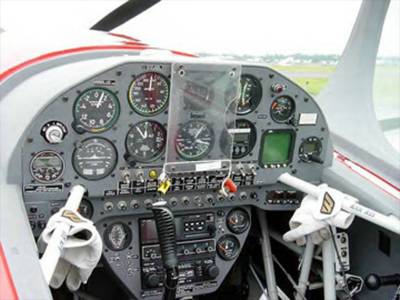
Usually you plan your takeoffs, but there are times you have to fly earlier than scheduled due to someone else's airplane breaking, an accident, or something like that.
I've had to make a few emergency landings as well...so yes, you have to prepare for any eventuality.
I've had to fly early because someone had crashed. It's difficult flying over the wreckage of an airplane when you knew the pilot.
STUNT FLYING
Like anything different, people consider being a stunt pilot very
"glamorous". At times it is, but at times it's work, just like anything else.
Being on the road, traveling, away from home, in mediocre hotel rooms, etc. can get really old and depressing. It's not all fun and games and can be exhausting.
But flying gives you freedom. I've never felt bored flying, and it's always been a challenge. When flying, I've never felt that I've wasted my time.
 Photo: Budd Davisson
Photo: Budd Davisson
I’ve been involved with stunts for
"Drop Zone," "Up Close & Personal," "Lois and Clark," "Discovery Wings," The Learning Channel, ESPN, Speedvision, and lots of others.
In stunt flying for movies and television, there are a number of things a pilot can be asked to do.
A fixed wing (as opposed to helicopter pilot) can be asked to do low-level aerobatics, land on top of a truck, land on a road, fly under a bridge, crash an airplane, make the airplane look out of control.
A helicopter pilot will either be a "photo platform," or be used in an action sequence during a movie.
Watch
"The Italian Job" for a great action sequence with a helicopter in it. The sequence was actually filmed by another helicopter.
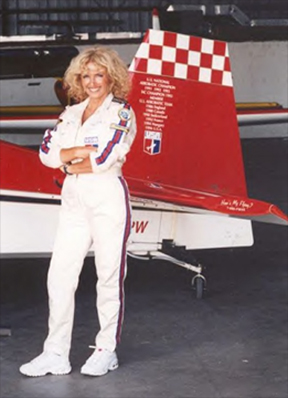
There are certainly risks involved, but those risks can be minimized. Most pilots will tell you that we don't consider any of it particularly dangerous, if flown within the limitations of the equipment and the skill level of the pilot.
As a woman, you have to work even harder to appear professional. I've worked very hard at that. A lot of people watching me fly think it's a man in the cockpit. When I land and get out, they’re surprised [that the pilot is a woman].
Some of the maneuvers I perform are the inverted ribbon cut, torque rolls and lomcevaks, snap rolls, rolls, avalanches and tumbling cartwheels.
I really enjoy performing the inverted ribbon cut. This is where I have a ribbon stretched across two poles that are 22 feet high. People hold the poles up and I fly upside down and cut the ribbon with my propeller.
I try to keep my 12-minute airshow routine rocking and rolling, moving fast during the entire time so I don't "lose" the spectators, and keep them excited the whole time, from take off to landing.
I travel at least l00-plus days a year. I've flown in some wonderful and exotic places -- Argentina, Russia, Hungary, Kenya and, recently, in Iceland.
I took off to fly an airshow in Rekyavik and looked down at a geyser shooting straight up at me. The most difficult conditions have been on film sets (flying skydivers off narrow runways in turbine aircraft, etc.)
None of it has been scary, but I have to admit I've gotten lower than I've intended to a couple of times and scared myself. It has always been a wake up call to focus more and take it more seriously and to never be complacent.
I think the weirdest thing I've done was the first time I did an inverted ribbon cut. It was just a very weird, strange feeling, being that low, seeing the ribbons coming up to you, flying through them.
MARGIN OF ERROR
You have to be very careful what you do right after takeoff. Some pilots do a snap roll on take off. A snap roll is a high speed, stalled roll. I will do that, but only on an upwards vector, climbing as I do it.
If something goes wrong or if you've forgotten something -- like switching to the aerobatic fuel tank (which enables you to fly inverted), or have something floating around in the cockpit (like a chart, or screw driver) by mistake, then it will make itself evident right after your takeoff.

I've never had an accident. I've had a few little incidents, like hitting my propeller, etc., but nothing where I was injured. I was in an accident once in Alaska...but that was as a passenger, and before I learned to fly.
The airplane went off the end of a soggy, muddy runway and we flipped upside down. No one was hurt, but it was pretty strange.
COMING UP
I've just returned from my fourth visit to Kenya. Working with the Kenya Wildlife Service has been extremely rewarding. I’ve just returned from my fourth year of working with the pilots.
I give the pilots recurrency training, some bush pilot training and aerobatic training and of course, have learned a lot from them too. Giving aerobatic training to pilots who do dangerous, low-level work in difficult conditions in the bush (like chasing cattle out of National parks, looking for and catching elephant and rhino poachers, etc.) is important, as it gives a pilot much more confidence and awareness of their airplanes.
I've always wanted to go to Africa, and Kenya in particular, so to be able to combine travel with working and volunteering has been an incredible experience for me.
I'm also getting my airplanes ready for the airshow season. I’m looking for a new major sponsor.
My airplanes are now going through their "annual inspection." The aerobatic airplane gets torn down and checked over very carefully each winter, and a new engine is built up that is modified especially for top performance.
I’m going to be flying the Texan II for Raytheon at the Farnborough Airshow in the United Kingdom this summer.

This summer I will be inducted into the
National Aviation Hall of Fame in Dayton, Ohio. This is a huge honor, so I am getting ready for that. I am on the Board of the
National Air & Space Museum in Washington DC and will be going to Board meetings. I lead a pretty active life.
I don't want to look back at a certain age and regret that I didn't do everything I could have done. Life is short and there are no guarantees for a tomorrow, so I want to take advantage of the opportunities that come my way and the opportunities that I can create.
I don't know what the future will bring, but I feel that I have other exciting things coming my way in the future.
There's a saying, "Life is mysterious, don't take it serious." While that's easier said than done, it's a good thing to remember. People, myself included, tend to worry too much.
There's also something we all need to remember, myself definitely included...as soon as one door closes, another opens.
Just be ready for the open door and don't be afraid to take a gamble.
Bio: Raised in Japan, professional stunt pilot
Patty Wagstaff was the first woman to win the title of U.S. National Aerobatic Champion. Her stunt work has been featured on ESPN, and in "Up Close and Personal" and "Drop Zone". She is the co-author of
"Fire and Air: A Life on the Edge" She has trained with the Russian Aerobatic Team and flown airshows and competitions on five continents.
Official site: Patty Wagstaff
RELATED EXTRAS: More about Patty Wagstaff
Movies:
I'm a big movie nut and have seen hundreds of them.
Sad movies –
"The Horse Whisperer," "On the Waterfront"
Funny movies - I love the Coen Brothers' movies,
"Fargo," "The Big Lebowski," "O Brother Where Art Thou?"...movies like that.
Downtime:
I have a lot of hobbies, but my most favorite thing besides spending time with my pets is riding horses. I enjoy it for similar reasons that I enjoy flying...it's always a challenge and there is always something to learn.
In other ways I enjoy it because it is really good for my soul to be out at the barn with the horses. You can't rush anything, because horses are sensitive, intelligent creatures. You have to take your time while dealing with them, so they force you to slow down and listen.
Riding itself is a challenge, because I want to improve my skills and learn to ride with rhythm and understand my horse. It's a quiet place to be. I also love to go the beach with my dogs and watch them run.
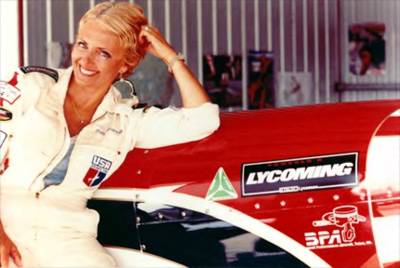 Favorite quotes:
Favorite quotes:
There's one that describes me that I like, from Mark Twain:
"She was not quite what you would call refined. She was not quite what you would call unrefined. She was the kind of person that keeps a parrot."
Other favorite quotes: Neil Young, from "Comes a Time"
"You and I, we were captured
we took our souls and we flew away
we were right, we were giving
that's how we kept what we gave away."
My recommendation for something new to do this month:
Adopt a pet, but know that it's a big commitment. Animals give you more than you give them. They also make us more human.
Interesting fact that nobody knows about me yet:
I am very shy.
Writing:
I think creative people are usually creative in many areas of life. I've already written a book,
"Fire and Air: A Life on the Edge," with a co-author. It's my life story up until about 1994, but so much has happened since then, that I'd like to write another book. I've written songs, but particularly enjoy writing lyrics. And I've had a couple of poems published.
I've written so much in the past, and one of the reasons I wrote my book was so I didn't have to answer too many more questions. But so much has happened during the past ten years that it would take another book to discuss it. I would like to write another book, but not autobiographical...I'm just not sure what format it will take. I'm sure it will come to me.
Philosophy:
Life is...a long strange journey. Don't take it too seriously.

RELATED EXTRAS: NAHF TRIVIA
Patty Wagstaff was inducted into the National Aviation Hall of Fame on July 17, 2004. Actor and pilot Dennis Quaid served as the master-of-ceremonies for the 43rd Annual "Oscar Night of Aviation."
This year, the NAHF honored Wagstaff, former astronaut William A. Anders, the late Harriet Quimby, America’s first officially licensed woman pilot; and the late Jack L. Ridley, pioneering flight test engineer/pilot.
Past inductees include
Louise Thaden (a stunt pilot and co-founder of the
The Ninety-Nines, with
Ruth Nichols and Amelia Earhart), Wilbur and Orville Wright, Neil Armstrong, Buzz Aldrin,
Anne Lindbergh,
Jacqueline "Jackie" Cochran, industrialist
Olive Beech and Alexander Graham Bell.
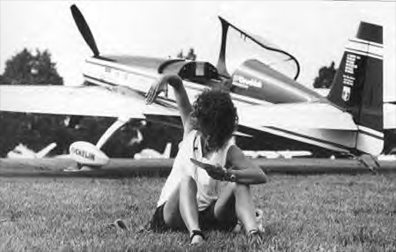
RELATED EXTRAS: EXCERPT, "FIRE AND AIR"
I am in my element -- the air.
I am suspended, surrounded by that which claws at my every sense: swirling clouds and an acrid mixture of lubricants, outside air, faint exhaust fumes, and, occasionally, a whiff of something sweet and pungent that I can't identify.
The control stick is molded to my fingers. I squeeze tightly, then my touch is light; my hands are inquiring yet positive. My feet, never still, respond to every pressure of my toes -- pressing, relaxing, rhythmic like those of a dancer.
I sight the horizon, envisioning a distinct line even when it is faintly obscured with blurred stands of evergreens and mauve-colored hills.
I choose section lines on the surface to choreograph my routine, never losing sight of where I am in space the way a twirling ballet dancer focuses on a single spot on a stage to maintain balance.
This is where I belong and where I feel alive, even joyous. Each time I fly aerobatics, I feel more at home in my machine and in the air.
I believe in the elements; air, earth, water, and fire. I believe that people are basically elemental...
From:
"Fire and Air: A Life on the Edge"
(c) 1997, Patty Wagstaff, Ann L. Hooper. All rights reserved.
All images (c)
Patty Wagstaff Airshows, except as indicated by respective photo credit.
Additional books by/about female aviators:
"Night Witches," "East to the Dawn: The Life of Amelia Earhart," "Queen Bess," "20 Hours, 40 Min: Our Flight in the Friendship," "Leaving Earth: A Novel," "West With the Night," "Women and Flight: Portraits of Contemporary Women Pilots," "Amelia Earhart's Daughters,",
"Promised the Moon," "The Mercury 13," "Before Amelia,",
"Crosswind," "Red Line," "Amelia Earhart's Shoes," "High, Wide and Frightened," "Lyrical Aviators," "The Happy Bottom Riding Club: The Life and Times of Pancho Barnes"
Read in-depth interviews with other performing artists, in the OCT/NOV issue of "
Arte Six."
Original post date, "Arte Six", APRIL 2004.

